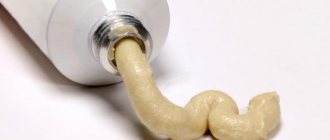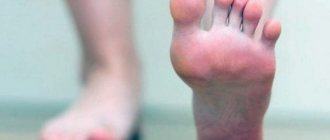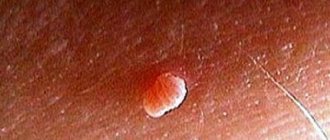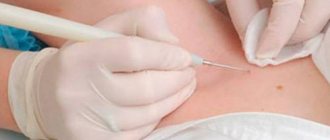Papillomas on the neck are the result of infection of the body with the human papillomavirus. Unfortunately, once infection has already occurred, the virus cannot be removed from the body. Against the background of weakened immunity, a chronic course of papillomavirus infection and the appearance of external symptoms in the form of papillomas and warts are noted. With strong immunity, the body is able to defeat pathogenic viral activity and prevent any complications associated with HPV. Clinicians recommend removal of papillary lesions on the neck along with intensive antiviral and immunomodulatory therapy. If these methods cannot be carried out for any reason, then some patients decide to try to remove the growths themselves. In this article we will tell you how to remove papillomas on the neck at home.
General information
Papillomas are formations on the skin that appear as a result of the proliferation of epithelial cells. Their appearance is associated with the human papillomavirus (HPV).
This is a very common virus. Statistics show that about 70% of people in the world are infected with it, and 90% of the planet's inhabitants are carriers of HPV. At the same time, characteristic growths - papillomas - are not found in all people. It is important to consider that some strains of the virus may have oncogenic properties and lead to tissue transformation into malignant tumors. But in most cases, these are benign formations that look like a soft growth on the skin that is brown or flesh-colored.
Such formations can appear in different places - both on the skin and on the mucous membranes. Quite often they appear on the neck. What factors provoke their appearance and how to get rid of such formations will be discussed in this article.
Reasons for the disappearance of papilloma
The process of disappearance of papillomas can be painless and unnoticed by the patient.
However, if accidentally injured, ulcers, crusts, or wounds may form. In such cases, two options for further development are possible: the wart dries up and falls off, or its malignant degeneration is observed.
When asked by the patient whether the papilloma can fall off on its own, experts answer unequivocally. This option is possible; tumors fall off under the influence of various factors.
The main reasons why such growths disappear include:
- Puberty. In adolescents, hormonal changes occur during puberty. At this time, they are actively exfoliating the surface layers of the epithelium. As a result, papillomatous cells move into this upper layer and gradually disappear.
- Pregnancy. With this condition, there is also a change in hormonal levels, which can lead to the spontaneous removal of warts. The presence of human papillomavirus in a pregnant woman can contribute to the development of fetal disease. A newborn's risk of developing warts in the larynx increases. Therefore, before pregnancy, a woman infected with this virus must undergo the necessary course of treatment. If this does not happen, the pregnant woman should not try to remove these formations at home. This can lead to negative consequences.
- Treatment of an infectious disease. The use of antiviral and immunomodulatory drugs used to treat other infections (herpes virus, mononucleosis) can have a positive effect on HPV. Since similar medications are used to treat papillomas, taking the appropriate course can cause spontaneous recovery from warts.
- Random mechanical removal of growths. Papillomas located on the scalp, back or groin are subject to constant traumatization by clothing or a comb. After such exposure, the papilloma may turn black and fall off. Thus, as a result of damage, the wart first darkens, then turns black, and only after that the blackened growth falls off. This is the most favorable outcome. The pigmentation of the skin remains for some time, which then acquires the color of the surrounding tissues.
In any of the above cases, spontaneous disappearance of papillomas is observed with exogenous or endogenous stimulation of the immune system.
Pathogenesis
Papillomas develop from squamous or transitional epithelium. When a certain type of HPV infects a type of epithelium, characteristic changes in the skin occur. After infection has occurred, normal differentiation is observed in epidermal cells. In the cells of the spinous layer, clonal expansion, transformation and malignization of infected cells of the basal layer, which have undergone only primary differentiation, occur. When the cells of the stratum spinosum move into the stratum granulosum, they are very active in producing viral DNA. The assembly of mature viral particles occurs in the stratum corneum, followed by their release and budding on the surface of the epithelium or epidermis. Upon contact with these areas, infection occurs. Sometimes cellular immunity , blocking the persistence of the virus, leads to spontaneous regression of the lesions. However, contamination of neighboring areas may also occur. With HPV, cellular immunity is very often reduced and interferon .
What to do if the papilloma falls off on its own
Diagnosis by a dermatologist
If the reason that the growth falls off is due to strengthening of the immune system, then this happens absolutely painlessly, but some actions need to be taken.
- At first glance, the site of the former location of the papilloma may look almost undamaged, but it still needs to be treated with an antiseptic.
- If only part of the papilloma has dried and fallen off, it is necessary not only to treat the remainder, but also to consult a doctor.
- If, after the papilloma has fallen off, a bleeding wound remains, measures should be taken to protect it. In this case, the skin around the wound is also treated with an antiseptic, after which the damaged area must be covered with an adhesive plaster or bandaged. In this case, contacting a specialist is necessary, because the roots of papilloma could remain inside, which will certainly lead to its new growth.
- If the papilloma was removed mechanically, the steps for treating the wound are exactly the same. It would not be amiss to present the missing piece of formation to the dermatologist so that he can conduct the necessary research, determine which strain of HPV the patient is affected by, and prescribe high-quality and correct treatment.
There is no need to panic or be overly nervous, even if you cannot immediately stop the bleeding from the resulting wound. This should be treated as if it were a normal injury. The only thing you need to do is consult a doctor.
Classification
There are several types of papillomas that can appear on the neck and other places:
- Thread-like - a yellowish formation, grows quickly, has a long stalk, and a ball at the end.
- Flat – protrude slightly above the skin, pink or brown.
- Simple or vulgar - large formations with dense irregular edges protrude several millimeters above the skin.
Most often, flat papillomas and warts appear in the neck area.
Taking into account the degree of oncogenicity, the following types of such formations are distinguished:
- Low degree - the risk of developing a malignant process is likely only in the presence of a hereditary predisposition.
- Moderate degree - a malignant process can develop if there is constant exposure to harmful factors, both external and internal.
- High degree - high probability of developing a malignant tumor.
Is it possible to remove growths yourself?
Despite the fact that papillomas cause psychological discomfort to many people and worsen their appearance, under no circumstances should they be mechanically removed at home. Simply cutting off these formations with a knife or scissors can lead to their malignant degeneration.
You can use a lapis pencil to remove warts.
You can remove single, superficially located small warts yourself. To do this, it is recommended to apply ointments, creams or cauterization. In this case, you can use the local application of the following types of pharmaceutical drugs:
- Necrotizing and mummifying. These products contain alkalis or acids. The most well-known include: solcoderm, feresol, verrucacid, lapis pencil. The skin around the wart is treated with Vaseline or fatty oil and the formation itself is carefully cauterized. The systematic use of such drugs contributes to the death of the upper stratum corneum.
- Keratolytic. Salicylic acid or ointment, salipod patch is recommended to be applied every other day. They must be applied with caution, without touching healthy, undamaged tissue. These medications are considered the most effective and safe in the topical treatment of HPV.
- Refrigerants. For self-cauterization, use Wartnercryo or cryopharm in the form of aerosols. This method is quite traumatic. However, after its use, the papilloma falls off. At first, the surface of the wart may swell, dry out, or form a blister. After the bubble opens or the wound dries, dried crusts appear, which subsequently fall off.
- Antiviral. For this purpose, the following medications are used: Viferon, Panavir, Kipferon, Oxolin. They block the papillomavirus, the pathogen cannot penetrate the basal layer of the skin, which contributes to the reverse development of the infection. When warts are localized on mucous membranes, only antiviral drugs (suppositories, creams or ointments) can be used.
To achieve the best effect, a combination of several methods is possible. Tablet and injection forms are also used to treat warts. These are serious medications that should be used only on the recommendation and under the supervision of your doctor.
Effective folk remedies include the use of acetic acid. You can take 9% essence or regular table vinegar. Dip a cotton swab into this liquid and gently apply it to the wart. Repeat several times a day until it disappears completely. This option is approved for use on the skin only.
Another common treatment method is celandine. The juice of this plant is dripped onto the area where the papillomas are located. It is advisable to use freshly cut celandine in spring or summer. This method has no side effects. To destroy warts, its use for 3-4 weeks is enough.
To remove papillomas and warts, apply fresh celandine juice to them.
Causes of papillomas on the neck
HPV infection can occur through sexual contact, in everyday life through contact with the skin or mucous membranes of an infected person, during childbirth - from mother to baby.
If a person is a carrier of HPV, very often the virus does not manifest itself in any way for a certain period of time. The reasons why small papillomas appear on the neck are associated with a weakened immune system, a deterioration of both local and general immunity.
Speaking about what causes small papillomas and why such formations grow, it should be taken into account that their formation can be influenced by the following factors:
- Hypothermia.
- Regular and severe stress.
- Excessive physical activity.
- Chronic fatigue.
- Hormonal disorders.
- Diseases of the gallbladder, kidneys, pancreas, pelvic organs.
- Infectious diseases.
- Avitaminosis.
- Autoimmune diseases.
- Promiscuous and unprotected sexual intercourse.
- Excessive exposure to ultraviolet radiation on the body.
Sometimes a person notices that small papillomas on the neck have appeared or become inflamed after prolonged use of certain medications, chemotherapy , or radiation therapy .
Speaking about why papillomas appear on the neck of women, it should be noted that such formations can appear during pregnancy , when active hormonal changes occur in the body and immunity .
During the period of bearing a baby, small papillomas on the neck and in other places may increase, and their number may increase.
Disease prevention
It is impossible for a person to completely protect his body from infection with papillomavirus. But you can always take care of reducing the risk of developing the disease by following simple rules:
- Regularly, especially in hot weather, wipe your neck with antibacterial wipes;
- never use other people’s personal hygiene products;
- wash your hands every time you visit a public toilet;
- be attentive to the condition of the skin;
- avoid microtrauma of the skin of the neck;
- take care of your general health, preventing the development of hypovitaminosis, anemia, and decreased immunity.
Currently, medicine offers many methods for removing papillomas on the neck. Naturally, none of them is a radical option for eliminating the problem, but, nevertheless, it allows you to remove formations caused by the papilloma virus. It is important to remember that only a qualified doctor can rid a person of growths by using the most effective means in relation to the disease in each individual case.
Symptoms
Such formations on the neck are generally soft or hard tumors that are pedunculated or broad-based. The size of such formations is 1-2 cm. The color can be either flesh-colored or brown. The outer surface is rough. Sometimes the papilloma grows in different directions and becomes like a cauliflower or cockscomb.
Depending on the type of virus, the symptoms may differ. In the neck area most often formed:
- Flat papillomas - look like bumps with a smooth surface. Their color is the same as healthy skin.
- Filiform papillomas are small yellow bumps that over time can transform into oblong-shaped compactions and reach up to 6 mm.
- Simple warts are formations that protrude 1-2 mm above the skin, may be slightly darker than the skin, and have uneven, dense edges.
Why might it fall off?
Experts identify 3 reasons that provoke the disappearance of papilloma:
- Since the main impetus for the appearance of tumors is a weakening of the immune system, restoration of immunity will cause their disappearance.
- With the appearance of hemangioma , a benign neoplasm, the papilloma begins to darken and after a while disappears. But you shouldn’t relax; the appearance of any formations on the body is a reason to check and consult with an oncologist.
- Hormonal background of the body . After fluctuations in hormones (puberty, pregnancy), sooner or later the state of the hormonal system will normalize, and papillomas can successfully disappear, as unexpectedly as they appeared.
Trauma warts
Injury to papilloma is a common phenomenon; it is easy to get hurt when wiping with a towel, wearing jewelry on the neck, shaving, and also as a result of rubbing clothes.
Microtrauma of the formation is usually indicated by its redness. Redness can also appear if an infection gets inside. In any case, you should consult a doctor.
Self-removal
You cannot get rid of papilloma on your own! The ban concerns “treatment” using folk methods and “miracle recipes” from the Internet: treating viruses with homemade methods is, at a minimum, illogical.
The result of such “treatment” is deep skin burns, scars, pigmentation, and the appearance of even more formations.
You can use pharmaceutical drugs for these purposes, but only after consultation and examination by a doctor. If the formation does not pose a threat, you can very carefully and accurately, in order to avoid contact with areas of healthy skin, apply one of the drugs to the papilloma: “Cryoderma”, “Ferezol”, “Superchistotel”.
But it is still better to carry out such a procedure in a medical institution; fortunately, there are currently a large number of painless and safe ways to remove such a formation.
Possible consequences
If the papilloma is damaged or completely torn off (not to be confused with falling off) and the person does not seek help from a doctor, the consequences can be extremely undesirable: several new growths may form on the affected area; A permanently non-healing wound will serve as a source of development of the inflammatory process in this area and the body as a whole.
And the worst consequence of such a phenomenon is the possible degeneration of a torn papilloma or its root into a malignant tumor, and if the process of cancerous degeneration has already occurred in the papilloma, then due to damage, cancer cells can enter the bloodstream and spread throughout the body, then there are metastases.
Papilloma is not just a cosmetic defect; it is a sign that there is a virus in the body that manifests itself externally in people with weakened immune systems.
You should not attempt to remove the formation on your own; changes and damage to the papilloma should not be ignored. The only right steps are to contact a medical institution for advice and help, as well as review your lifestyle and strive to make it correct.
Tests and diagnostics
If such formations appear on the neck, you need to visit a dermatologist. If necessary, he can advise which other doctor should be consulted. Initially, the specialist examines and interviews the patient, determining the characteristics of papillomas, the time of their appearance and the factors that could provoke it.
Additional laboratory and laboratory tests are also prescribed:
- General and biochemical laboratory blood tests.
- Carrying out a biopsy , for which material is removed.
- Polymerase chain reaction method (allows you to determine the presence and type of HPV).
How to treat a wound
If one or more papillomas have come off, you need to treat the wound with an antiseptic drug to stop the bleeding. In this case, the bleeding is capillary; hydrogen peroxide is enough to stop it. Peroxide has an antiseptic effect due to the formation of atomic oxygen, which cleanses the wound of contamination.
If peroxide is not on hand, you can use a tight bandage or finger pressure.
Potassium permanganate is a representative of oxidizing antiseptics. It has an antimicrobial, astringent, cauterizing effect. A slightly pinkish solution is sufficient for processing.
Among other antiseptics, it is permissible to use:
- boric acid;
- sodium bicarbonate (soda);
- chlorhexidine;
- betadine;
- Lugol's solution;
- brilliant green.
Brilliant green, Lugol's solution, betadine have a significant drawback - they stain the wound surface and the skin around it, and it is not possible to objectively assess the condition. Preference is given to chlorhexidine, hydrogen peroxide, and acids.
In case of extensive damage, it is impossible to treat the area where the papilloma was located with antiseptics with a strong irritating effect. You can use chlorhexidine, betadine.
After applying the antiseptic, apply an aseptic bandage. It is forbidden to wet the wound in the first days.
Treatment with folk remedies
Folk remedies can be used as auxiliary methods during treatment. But before using them, you should definitely consult your doctor. The following traditional medicines can be used:
- Garlic ointment . It is necessary to grind the garlic and mix it with the same amount of Vaseline. Apply to papillomas every day. An ointment is prepared in the same way, replacing the garlic with young stems of celandine.
- Laundry soap . Since soap, when it gets on the skin, creates an alkaline environment, it is used to treat papillomas on the skin. Before going to bed, you need to rub them with laundry soap. This procedure must be carried out every day for a month.
- Celandine . Every day, the formations need to be treated with celandine juice, after which cotton wool soaked in the juice of the plant should be applied on top and sealed with a band-aid. This treatment should be carried out for a month or longer.
- Castor oil . Twice a day you need to rub castor oil into the places where formations have appeared.
Medications
Pharmaceutical preparations contain complexes of chemical substances on an alkaline or acid basis that destroy the tissue of papillomas - mummifying or cauterizing.
Important!
Healthy skin near formations can also be subject to aggressive effects, so care must be taken to protect it. You can use a patch or compression paper with cut holes, generously lubricate the surface around the papillomas with greasy cream or Vaseline.
The list of the most preferred medications for home treatment includes the following drugs:
- Cryopharma . It is a special refrigerant packaged in an aerosol can. The kit includes 12 porous soft applicators and a special nozzle. The removal procedure is similar to clinical freezing of papillomas, but without liquid nitrogen. Cryopharma contains a mixture of ethers and propane compounds, which turns into ice crystals in air. Applicators allow you to apply the drug precisely to the papilloma. Under the influence of the refrigerant, the neoplasm becomes necrotic - its tissues stop receiving nutrition, are destroyed and are gradually rejected. After the application procedure, which lasts 10-20 seconds. papillomas change shape and color, and then fall off within 10-12 days, leaving a thin crust on the skin. After a few days it disappears. If lesions exceed 3 mm in diameter, a secondary freezing session may be required after 2 weeks. The bottle contains 35 ml of product, which is enough for several uses. It is not necessary to cover and bandage papillomas after treatment. Cryopharma is the most convenient and effective medicine for neck papillomas, which has virtually no side effects. However, precautions are necessary. You can safely use the drug on the back, less sensitive, surface of the neck. Contraindications include inflammatory skin diseases, abrasions, wounds, and scratching. The reasons for banning Cryopharma are: pregnancy, poor blood clotting, diabetes.
- Collomak . Liquid containing salicylic, lactic acid, polidocanol. It has a rather mild effect, gradually destroying the structure of pathological formations. The solution is packaged in glass bottles with a capacity of 10 ml. Apply a drop of the product to each papilloma, repeating the treatment twice a day. Complete death of the tumors occurs within a week.
- Feresol . Oily brown solution based on phenol with tricresol. The 10 gram bottle of the drug is equipped with a dispenser. When applied to papillomas, their tissues are cauterized and subsequently necrotized. The solution is quite aggressive. The skin around the papillomas must be covered with Vaseline or zinc paste. Caution and extreme accuracy must be observed when applying to the front or side of the neck. One application is enough to remove small papillomas. The active substances of the drug have pronounced bactericidal properties. If the size of the new growths exceeds 3-4 mm, after drying the product it is necessary to apply a second layer. While using Feresol, a slight burning or tingling sensation may occur. Complete drying and rejection of papillomatous tissue occurs after 2 weeks.
- Super Celandine . The commercial name of the drug does not indicate the presence of celandine extract in it. This is a solution of potassium and sodium salts with water. The concentration of alkalis in the product is such that it allows the destruction of papillomatous tissue, leading to their death.
- Verrucacid. An effective remedy for papillomas on the neck. Liquid oily preparation with a high content of phenol and metacresol. These chemicals cause the protein components of papillomas to fold, causing them to mummify. Small formations need to be treated once, those larger than 3 mm require 4-5 applications of the drug. After treatment, short-term painful sensations are possible.
Diet
Diet to boost immunity
- Efficacy: therapeutic effect after 3 weeks
- Terms: 1-3 months or more
- Cost of products: 1600-1800 rubles. in Week
Nutrition should be complete and varied, since it is very important to compensate for the deficiency of vitamins and minerals in order to strengthen the patient’s immunity. The following products must be included in the menu:
- Peppers, citrus fruits, currants, rosehip decoction, sauerkraut - they contain a lot of vitamin C.
- Sea fish.
- Vegetable oils.
- Greens, fresh vegetables.
- Lean meats.
- Dairy products.
- Honey.
The following products should be excluded from the menu:
- Fried food.
- Sugar, sweets.
- Alcohol.
- Animal fats.
- Preservatives, smoked products.
First aid
What to do if the papilloma comes off will depend on the specifics of the damage.
When cutting or tearing off the papilloma, heavy bleeding is observed. The blood needs to be stopped; it will continue to flow for a very long time.
First, the wound should be treated with any antiseptic to avoid infection. Then you need to take a piece of cotton wool or bandage and press it tightly to the wound. You need to hold the compress for several minutes until the blood stops flowing. Then re-treatment with an antiseptic is carried out. If the head of the growth has moved away, but has not come off completely, it is necessary to fix the papilloma in one position with an adhesive plaster. It is possible that after a few hours it will come off on its own.
If the papilloma has partially come off, it needs to be covered with a band-aid after treatment.
When rubbing a papilloma, it is necessary to secure a soft bandage over the growth, which will protect it from further damage. A wait-and-see approach is chosen; the condition of the papilloma should be monitored for several days. If there is no discomfort, the growth has not changed color, size or shape, you can do nothing. If after a few days the papilloma has enlarged and is itchy, you should consult a doctor.
Salicylic-zinc paste
Dermatologists often prescribe salicylic-zinc paste both for removing warts and for accidental injury to various tumors, since the components of the medication prevent pathogenic microorganisms from entering the wound and their further spread.
The ointment does not cope with the papilloma virus, but it eliminates the symptomatic manifestations of the pathological process, drying the affected areas and removing small growths.
San Fen Zhong
Antiviral Chinese ointment for the treatment of benign lumps, which has bactericidal properties. The product contains extracts of peppermint and ebony, salicylic and acetic acids, which ensure rapid removal of papilloma. Users note that the growths disappear after just 5 days of regular use of the drug.
Important!
Unlike other ointments, San Fen Zhong is applied for only 5 minutes, after which it is washed off with warm water.
Stefalin
A remedy against warty growths made from medicinal herbs. There are no chemical components in the composition of the drug. The ointment helps eliminate lumps that appear on the neck and other parts of the body with minimal pain, but can cause an allergic reaction in the form of a rash and redness of the skin.
Important!
The drug has not undergone clinical trials, so there is no data on its safety and effectiveness. Experts do not recommend using Stefalin.
Panavir
A drug based on natural ingredients that penetrate deep into infected tissues and destroy the papillomavirus. The ointment increases the body's resistance to infections, accelerates the regeneration process, relieves swelling, itching and burning.
The main active ingredient of the medication is potato extract, which includes many beneficial substances that have a positive effect on the condition of the skin. Sodium hydroxide, ethanol, glycerol and macrogol enhance the effect of the active ingredient, causing skin growths to disappear forever.
Viferon
Ointment for external treatment of viral infections, which has an immunomodulatory effect. The ointment contains interferon alpha-2b, which stops the spread of infection and prevents the emergence of new viruses. The basis of the medicine is made up of ingredients such as peach oil, lanolin, petroleum jelly and vitamin E.
The drug is safe for small children over the age of one year, pregnant and lactating women.
Oxolinic ointment
A proven medicine that guarantees the removal of seals in a short period of time. Oxolin, which is part of the drug, exhibits antiviral activity and destroys the papilloma virus, and also eliminates warty growths without pain and other unpleasant sensations.
How do they look?
Cervical papillomatosis can have several forms of warts:
- Pointed - have one common base and many papillae at the edge. Soft and elastic, have a flesh-colored tint. Most susceptible to injury.
- Flat - look like a small round spot of pale brown color. External manifestations are similar to a mole.
- Filiform - single papillomas that look like thin threads 2-3 cm in height. When injured, they cause pain. An infection may develop at the wound site.
Papillomas are often confused with moles, but they have nothing in common. Papillomatosis is provoked by a virus, so it is impossible to get rid of it only by removing the tumor. Complex treatment carried out in stages is required.
Medicinal solutions for warts
Potent medicinal solutions quickly deal with skin tumors of viral etiology, having a destructive effect on infected cells and providing reliable protection against the reappearance of growths.
Important!
When using solutions to treat warts, you must take precautions and strictly follow the instructions for use.
Lapis pencil with silver nitrate
A popular remedy for removing papilloma and benign warts. Lapis pencil is rarely prescribed by dermatologists, but it is actively used by virus carriers.
The active component of the medication is silver nitrate, a substance that suppresses the activity of harmful microorganisms. As a result of applying the composition to areas affected by growths, necrosis of the treated tissue occurs. The seal dies and after some time the skin becomes smooth.
Super clean
An alkali-based pharmaceutical product designed to remove warty growths of any density using a chemical method. The active components of the solution create a chemical burn at the site of application, as a result of which the seals gradually die and fall off.
The composition of the drug also includes sodium bicarbonate and sodium chloride salts, which soften the aggressive effect of the solution on the skin and promote its regeneration.
Verrucacid
Antiseptic medicinal solution with a cauterizing effect. The medication blocks the spread of papillomavirus, destroys infected cells, promotes the removal of seals and affects the process of restoration of damaged tissues after the procedure to remove growths.
Important!
After using Verrucacid, there are no scars or cicatrices left on the skin, so the product is ideal for removing tumors that have appeared in prominent places.
Feresol
A combined type drug in the form of an oily solution for cleansing the skin of viral warts. During contact with neoplasms, the medication inhibits the vital activity of pathogenic microorganisms, provokes coagulation of the protein structure of the virus and destroys the cytoplasmic membrane.
The growths are treated over several days, after which a crust forms at the site of the compaction, which disappears after a week.
Basic methods for removing papillomas
- Cauterization using chemical acids. The essence of the method is to use an acid with a low pH and a high percentage; it is applied to the papilloma in order to form local coagulative necrosis. Typically nitric acid or trichloroacetic acid (TCA) is used. Cauterization is carried out once a week for 5-6 weeks. The combined drug Solcoderm is also used to cauterize papillomas. Solcoderm is an aqueous solution containing acetic, oxalic, lactic acids and metal ions with nitric acid. It is applied topically and causes immediate intravital tissue fixation followed by mummification of the affected tissue. Complications such as scarring and secondary infection are extremely rare. Advantages of the chemical method: - Cheaper method, does not require special equipment, can be performed by any dermatologist. Disadvantages of the chemical method: - Possibility of burning healthy tissues; - Possibility of scar formation.
- Surgical removal of papilloma is popular , meaning surgical removal of the tumor with a scalpel: surgical excision is performed by a surgeon in the operating room under local anesthesia. However, this is the most traumatic method and has a rather long rehabilitation period.
- Using the cryodestruction method, papillomas are quickly and almost painlessly “burned out” with liquid nitrogen . The only drawback of the method is that it is impossible to accurately control the depth of action of liquid nitrogen, so after some time it may be necessary to repeat the procedure. Liquid nitrogen is applied to the papilloma using a special apparatus or a simple cotton swab dipped in liquid nitrogen, pressed and held for 10 to 30 seconds. When a white coating appears on the surface, the procedure is stopped immediately. Nitrogen causes papilloma cells to be rejected and die. The advantage of this method is that a scar does not form on the surface of the skin. Disadvantages of cryodestruction: - Long-term rejection of the formation: from 14 days to 2 months; — The depth of exposure to liquid nitrogen is determined arbitrarily, so living cells infected with a virus may remain in the wound, which are quite capable of causing the growth of papillomas again (papillomatosis develops).
- The electrocoagulation method (point exposure to high-frequency current) is indicated for removing papillomas on the body, but is undesirable for removing growths on the face, since there is a possibility of scar formation. The papilloma is, as it were, “cauterized” by the electrode, as a result of which the tissues at the point of contact with the device simply die and are destroyed. To completely remove the formation from the surface of the skin and from the depths of the epidermis, doctors use electrodes of various lengths and thicknesses.
Advantages of electrocoagulation: - You can quickly excise all suspicious papillomas at any depth and area under the visual control of a surgeon; — The occurrence of bleeding is almost impossible; — The risk of infection entering the wound is minimal; — The tissues of the removed outgrowths remain unharmed and can be further examined for the presence of malignant cells. Disadvantages of electrocoagulation: - A scar may remain after healing; - You can get burned after removal; - Long-term healing.
Laser removal of papillomas. An alternative to such an intervention may be the use of a laser , which is less traumatic even when removing large papillomas. Laser removal of tumors has a number of undeniable advantages over the methods described above: - The required depth of impact on tissues affected by a viral infection is easily achieved thanks to high-precision focusing and correct selection of the laser wavelength; — Possibility of influencing the smallest tumor and even the remaining cells after other removal methods; — Minimal damage to healthy border skin tissues; — The area of damage and trauma to the skin is minimal compared to cryodestruction and electrocoagulation; — Virtually no bleeding; — Pain in the laser-treated area is minimal; — The seams are thin and reliable; — There is no infection in the wound, there is no swelling on the skin around; — Accelerated healing after laser exposure (good cell regeneration); — The scar is thin and invisible; — Complications are minimized, the rehabilitation period is minimal.
Disadvantages of removing papillomas with a laser: - The main disadvantage of the laser removal method is that papillomas cannot be examined histologically due to complete destruction of the cells. And if there is a suspicion that the tumor is malignant, then this method should not be used. — Swelling is possible if the patient is allergic to ultraviolet radiation.
- Radio wave removal of papillomas The radio wave method for removing papillomas can be considered one of the best methods, since after its use there is no deep tissue necrosis, the wound heals very quickly - within 2-3 days. The scar after papillomas remains thin, almost invisible. When compared with the electrocoagulation method, the degree of thermal damage to tissue using the radio wave method is 10 times less. In comparison with a laser - 2 times. Papilloma subjected to radio wave removal is not destroyed and can easily be used for further research for the presence of malignant cells. The radio wave method perfectly stops bleeding that began during surgery and prevents the development of pathogenic microorganisms in the wound. It is easy to control the depth of penetration and the number of cells removed thanks to an excellent overview of the operation site. The risk of local swelling and complications is minimal. Advantages of the radio wave method: Minimal pain during and after surgery; — During the removal of papillomas, the patient suffers a minimum of mechanical damage; — There is the possibility of histological examination of the removed polyp; — A thin, invisible postoperative scar at the site of removal.
After removing papillomas using any of the above methods, it is important during the rehabilitation period:
- Do not visit the sauna or bathhouse, have minimal contact with water (in some cases it is not recommended to wet the papilloma removal site for 4-5 days).
- To minimize ultraviolet radiation, it is recommended to lubricate the skin with products (creams, serums) with a high level of UV protection.
- Refuse to use decorative cosmetics.
Which method of removing papillomas to prefer depends on the type of papillomas, their number and the condition of the body. For example, laser removal of growths is not recommended during a cold, high blood pressure, herpes or fever. Contraindications for cryodestruction: individual intolerance to low temperatures, infectious disease at the time of the procedure, tuberculosis, diseases of the cardiovascular and nervous system.











